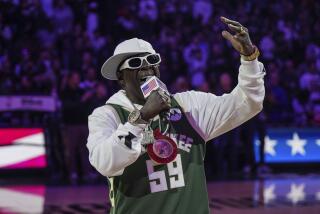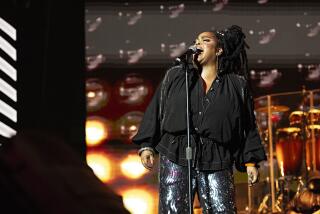O, Say, Can You See What’s Topping the Charts at Long Last?
- Share via
There’s a hot songwriting name topping the pop charts: Francis Scott Key.
A Georgetown lawyer who was inspired after a September attack on America’s East Coast scribbled his words on the back of an envelope to create what has become another platinum hit for Whitney Houston.
Houston recorded “The Star-Spangled Banner” during another time of battle--at Super Bowl XXV in 1991, when the Persian Gulf War was in full swing. Her rendition, later released on a single by public demand, reached only No. 20 that year.
But with its current re-release--with all proceeds going to families of uniformed victims of the Sept. 11 attacks--Houston’s version has surpassed the original. “The Star-Spangled Banner” is No. 1 on sales charts.
But because it’s getting hardly any radio airplay, it’s being held to No. 13 on the overall Billboard charts. That’s also the case for other patriotic songs riding high on the charts, led by Lee Greenwood’s “God Bless the U.S.A.”
For a country that prides itself as No. 1 in democracy, this is the first time its national anthem has hit No. 1 on the charts.
In fact, Houston’s version is only the second recording of “The Star-Spangled Banner” to make the charts. A live recording by Jose Feliciano recorded at the 1968 World Series reached No. 50. That’s not to say there haven’t been other popular versions of the anthem, including Marvin Gaye’s handling of the difficult song at the 1983 NBA All-Star game.
Hitting No. 1 in the 21st century wasn’t even a thought when Key composed the poem in the 19th century amid the smoke of the War of 1812.
Only a few decades after the Revolutionary War ended, America was fighting with England again, over the latter’s attempt to regulate U.S. shipping. British warships entered Chesapeake Bay in August 1814 and invaded the nation’s capital at Washington.
The Capitol Building and White House were set on fire, with flames visible 40 miles away. President James Madison and his cabinet fled to safer locations.
Key, in nearby Georgetown, was troubled by the mayhem but wrote his anthem only after sailing to Baltimore to try to help arrange a prisoner exchange. As that was going on, he was witness to the British bombardment of Fort McHenry near Baltimore on Sept. 13, 1814.
The fort had the kind of huge flag that has made a comeback in the last few weeks--30 by 42 feet--with its 15 stars measuring 2 feet wide, its stripes also 2 feet wide.
The bombing started at 7 a.m. and continued for 12 hours. The British fired 1,500 bombshells that were a little balky; some exploded in the air before they reached their targets. Their other new battle technology, Congrieve rockets, were detectable by their trailing red flames.
The Americans succeeded in sinking 22 British ships amid all these fireworks, though, and when the bombardment stopped at 1 a.m., the huge flag was still flying. Which was the point of the poem Key wrote in the form of a question when he got back to the Indian Queen Hotel in Baltimore.
His brother-in-law, a judge, circulated a few copies around Baltimore; one was published in the Baltimore Patriot newspaper on Sept. 20, 1814, under the title “Defence of Fort M’Henry.”
At some point it was suggested that the words go along with a hymn called “Anacreon in Heaven.” A Baltimore actor was credited with the first performance of it in October, calling it “The Star-Spangled Banner,” and it immediately became popular.
Keys died in 1843. He wouldn’t live to see his song designated as national anthem, which would come 88 years later, on March 3, 1931, 117 years after the song was written. Houston’s recording of it came another 60 years later.
The rise of “The Star-Spangled Banner” to No. 1 is not only a boost to national patriotism, it’s a boost for Houston. With it, she ties with R. Kelly for third place in the number of charting singles she’s had on the SoundScan singles chart in Billboard--19 (Madonna and Mariah Carey have each had 22 singles on the decade-old chart).
*
Roger Catlin writes about pop music for the Hartford Courant, a Tribune Co. newspaper.
More to Read
The biggest entertainment stories
Get our big stories about Hollywood, film, television, music, arts, culture and more right in your inbox as soon as they publish.
You may occasionally receive promotional content from the Los Angeles Times.










